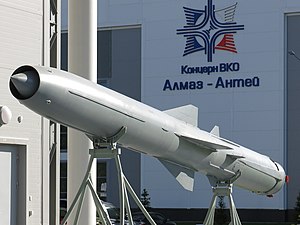Loading AI tools
Cruise missile From Wikipedia, the free encyclopedia
The P-800 Oniks (Russian: П-800 Оникс; English: Onyx), marketed in export as the Yakhont (Russian: Яхонт; English: ruby), is a Soviet/Russian supersonic anti-ship cruise missile developed by NPO Mashinostroyeniya as a ramjet version of P-80 Zubr. Its GRAU designation is 3M55, the air launched Kh-61 variant was planned but never built. The missile has the NATO codename SS-N-26 "Strobile". Development commenced in 1983,[6] and in the 1990s the anti-ship missile was tested on the Project 1234.7 ship. In 2002 the missile passed the whole range of trials and was commissioned.[7] It is reportedly a replacement for the P-270 Moskit, and possibly also of the P-700 Granit.
| Yakhont/Oniks missile | |
|---|---|
 A P-800 missile at Armia 2018 | |
| Type | Cruise missile Air-launched cruise missile Submarine-launched cruise missile Anti-ship missile Surface-to-surface missile Land-attack missile |
| Place of origin | Soviet Union / Russia |
| Service history | |
| In service | 2002–present[1] |
| Used by | See Operators |
| Wars | Syrian Civil War 2022 Russian invasion of Ukraine[2][unreliable source?] |
| Production history | |
| Manufacturer | NPO Mashinostroyeniya |
| Unit cost | $1.25 million[3] |
| Produced | 1987–present |
| Specifications | |
| Mass | 3,000 kg (6,614 lb) |
| Length | 8.9 m (29.2 ft) |
| Diameter | 0.7 m (2.3 ft) |
| Wingspan | 1.7 m (5.6 ft) |
| Warhead | national ver. 300 kg semi-armour piercing HE, thermonuclear; for export 200 kg semi-armour piercing HE[4] |
Detonation mechanism | delay fuze |
| Engine | Ramjet 4 tons of thrust |
| Propellant | jet fuel |
Operational range | 600 km (370 mi; 320 nmi) (Oniks version for Russia) 800 km (500 mi; 430 nmi) (Oniks-M version for Russia) 120 to 300 km (75 to 186 mi; 65 to 162 nmi) depending on altitude (Yakhont export version) |
| Flight ceiling | 14,000 m (46000 ft) |
| Flight altitude | 10 meters (32 ft) or higher |
| Maximum speed | Mach 2.9 ( 3180 km/h / 1998 mph / 884 m/s ) |
Guidance system | midcourse inertial guidance, active radar homing-passive radar seeker head |
| Accuracy | 1.5 m[5] |
Launch platform | coastal installations, naval ships, Fixed-wing aircraft |
The Oniks flies aerodynamically using its cropped delta wings mounted in a cruciform at the middle of the missile's fuselage. It possesses a very distinctive launch sequence which it shares with the BrahMos; the missile lifts up from its launch tubes, and engages a stabilizing sequence using brief pulses from rockets in its nosecone. The missile then reorients itself; a pair of more powerful rockets fire sequentially to turn the missile 90 degrees so that it is parallel to the surface, and thus the rocket begins its flight, ditching its nosecone to open its ramjet intake to the air.[citation needed]
In its initial flight, the Oniks utilizes thrust from a solid rocket booster mounted inside the combustion chamber of its ramjet to get up to cruise speed. Once the rocket engine is expended, the air pressure built up in the ramjet's intake kicks the rocket engine out, clearing the combustion chamber and starting the missile's self-sustaining ramjet cycle.[citation needed]
In 2010 Sergei Prikhodko, senior adviser to the Russian President, has said that Russia intends to deliver P-800 to Syria based on the contracts signed in 2007.[8][9] Syria received two Bastion missile systems with 36 missiles each (72 in total).[10] The missiles' test was broadcast by Syrian state TV.[11]
In May 2013, Russia continued the contract delivery to the Syrian government supplying missiles with an advanced radar to make them more effective to counter any future foreign military invasion.[12][13] A warehouse containing the Bastion missiles was destroyed by an Israeli air strike on Latakia on 5 July 2013, but US intelligence analysts believe that some missiles had been removed before the attack.[14]
Oniks missiles were reportedly used in 2016 against ISIL targets.[15][16][17]
The P-800 was used in the Russo-Ukrainian War. The Russian Defense Ministry announced that it had used the missile in 1 May 2022; reportedly a number of Oniks missiles were used to destroy military equipment around the city of Odesa.[18] On 19 July 2023, Oniks missiles were used to target Ukraine's grain storage facility in the Black Sea region.[citation needed]
Ukrainian Air Force Spokesperson Yurii Ihnat mentioned that the flight profile of the missile is of particular concern: "Onyx missiles are designed to destroy watercraft, and ships, it flies at a speed of 3000 km per hour, that is, very fast,... On the march [cruising], it can rise high, and when entering the target, it can actually fly 10–15 meters above the water to destroy the ship." He concluded that it was "impossible" to shoot them down with available anti-air means,[dubious – discuss] but he mentioned that some success was found when using electronic warfare against them; he mentioned that a missile attack on 23 September 2023 missed a military target and destroyed a "recreational area", adding that "something affected its flight."[19][20]
Russian sources reported on 27 March 2024 that the missile received a new active homing head in order to hit ground targets more precisely.[21]
On 20 August 2024, at the Congress of Local and Regional Authorities, Commander-in-Chief of the Armed Forces of Ukraine Oleksandr Syrskyi for the first time announced data on how many weapons Russia has used since 2022, as well as how many were intercepted. The report said that only 12/211 (5.69%) of Onyx were intercepted by Ukraine’s air defense[22]
Radar homing head
Standard batteries of the K-300 Bastion-P (Бастион-П-Подвижный):

Seamless Wikipedia browsing. On steroids.
Every time you click a link to Wikipedia, Wiktionary or Wikiquote in your browser's search results, it will show the modern Wikiwand interface.
Wikiwand extension is a five stars, simple, with minimum permission required to keep your browsing private, safe and transparent.